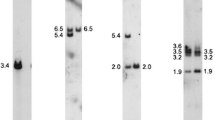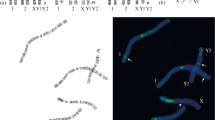Summary
Probes of uncloned Bkm satellite DNA and a Drosophila clone 2(8), consisting mainly of GATA repeasts related to a major sequence component in Bkm, have been used to probe Southern blots of human male and female DNAs obtained from a Caucasian and an Australian aboriginal population and to human chromosomes in situ. Hybridization was observed to a distinct and an indistint series of bands against a smeared background. The same distinct bands are identified in the DNA samples with both probes, but are most readily detected using the uncloned Bkm probe. Most restriction bands are common to both populations and some are polymorphic. However, certain bands appear to be characteristic of the Australian aboriginal samples. There are no distinct sex-linked patterns. However all of the small acrocentric human chromosomes, including the Y chromosome show hybridization to uncloned Bkm in situ.
Similar content being viewed by others
References
Bittner M, Kuppferer P, Morris CF (1980)Electrophoretic transfer of proteins and nucleic acids from slab gels to diazobenzyloxymethyl cellulose or nitrocellulose sheets. Anal Biochem 102:459–471
Epplen JT, McCarrey JR, Sutow S, Ohno S (1982) Base sequence of a cloned snake W chromosome fragment and identification of a male-specific putative mRNA in the mouse. Proc Natl Acad Sci USA 79:3798–3802
Goodfellow P, Darling S, Wolfe J (1985) The human Y chromosome. J Med Genet 22:329–344
Hu N, Messing J (1982) The making of strand-specific M13 probes. Gene 17:271–277
Jeffries AJ, Wilson U, Thein SL (1985) Hypervariable “minisatellite” regions in human DNA. Nature 314:67–73
Jones KW (1973) In situ hybridization. In: Pain IRH, Smith BJ (eds) New techniques in biophysics and cell biology. Wiley, London, pp 29–66
Jones KW,Singh L (1981a) Conserved sex-associated repeated DNA in vertebrates. In: Dover G, Flavell R (eds) Genome evolution, vol 20. Academic Press, London, pp 135–154
Jones KW, Singh L (1981b) Conserved repeated DNA sequences in vertebrate sex chromosomes. Hum Genet 58:46–53
Jones KW, Singh L (1985) Snakes and the evolution of sex chromosomes. Trends Genet 1:55–61
Jones KW, Singh L, Phillips C (1983) Conserved nucleotide sequences on sex chromosome. Proceedings of the John Innes Symposion, pp 265–287
Kiel-Metzger K, Warren G, Wilson GN, Erickson RP (1985) Evidence that the human Y chromosome does not contain clustered DNA sequences (Bkm) associated with heterogametic sex determination in other vertebrates. N Engl J Med 313:242–245
Maniatis T, Sim GK, Efstradiatis A, Kafatos FC (1976) Amplification and characterization of a globin gene synthesised in vitro. Cell 8:163–182
Rigby PWJ, Diekmann M, Rhoades C, Berg P (1970) Labeling deoxyribonucleic acid to a high specific activity in vitro by nick translation with DNA polymerase 1. J Mol Biol 113:237–251
Sapienza C, Doolittle WF (1982) Unusual physical organization of the Halobacterium genome. Nature 295:384–389
Singh L, Jones KW (1982) Sex reversal in the mouse (Mus musculus) is caused by a recurrent non-reciprocal crossover involving the X and an aberrant Y chromosome. Cell 27:205–216
Singh L, Jones KW (1984) The use of heparin as a simple cost-effective means of controlling background in nucleic acid hybridization procedures. Nucleic Acids Res 12:5627–5638
Singh J, Purdom IF, Jones KW (1977) Effect of different denaturing agents on the detectability of specific DNA sequences of varying base compositions by in situ hybridization. Chromosoma 60:377–389
Singh L, Purdom IF, Jones KW (1979) Behaviour of sex chromosome associated satellite DNAs in somatic and germ cells in snakes. Chromosoma 71:167–181
Singh L, Purdom IF, Jones KW (1980) Sex chromosome-associated satellite DNA. Evolution and conservation. Chromosoma 79:137–157
Singh L, Purdom IF, Jones KW (1981) Conserved sex-chromosome-associated nucleotide sequences in eukaryotes. Cold Spring Harbor Symp Quant Biol 45:805–813
Singh L, Phillips C, Jones KW (1984) The conserved nucleotide sequences of Bkm which define Sxr in the mouse are transcribed. Cell 36:111–120
Southern EM (1975) Detection of specific sequences among DNA fragments separated by gel electrophoresis. J Mol Biol 98:503–517
Wahl GM, Stern M, Stark GR (1979) Efficient transfer of large DNA fragments from agarose gels to diazobenzyloxymethyl paper and rapid hybridization by using dextran sulphate. Proc Natl Acad Sci USA 76:3683–3687
Wolfe J, Erickson RP Rigby PWJ, Goodfellow PN (1984) Cosmid clones derived from both euchromatic and heterochromatic regions of the human Y chromosome. EMBO J 3:1997–2003
Author information
Authors and Affiliations
Rights and permissions
About this article
Cite this article
Singh, L., Jones, K.W. Bkm sequences are polymorphic in humans and are clustered in pericentric regions of various acrocentric chromosomes including the Y. Hum Genet 73, 304–308 (1986). https://doi.org/10.1007/BF00279091
Received:
Revised:
Issue Date:
DOI: https://doi.org/10.1007/BF00279091




